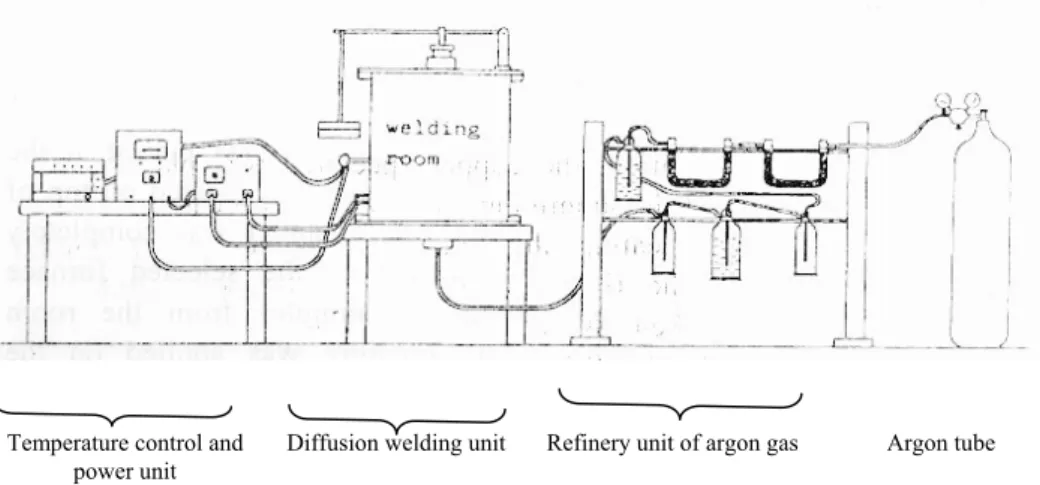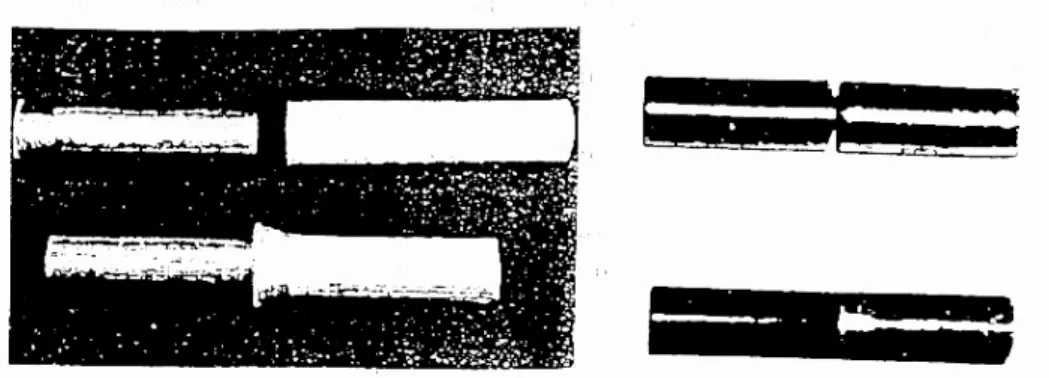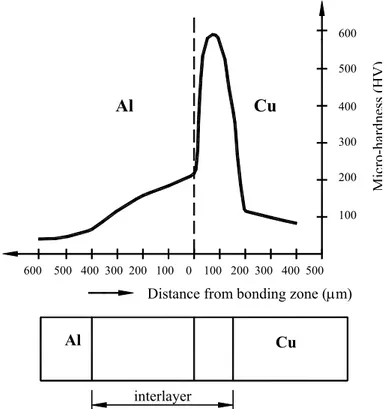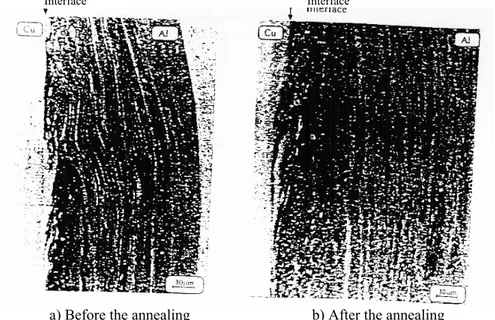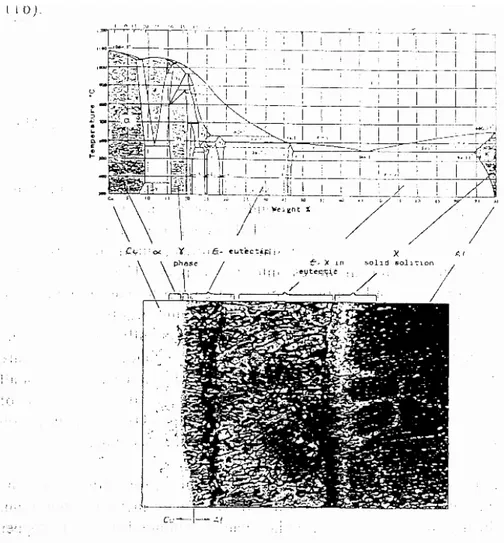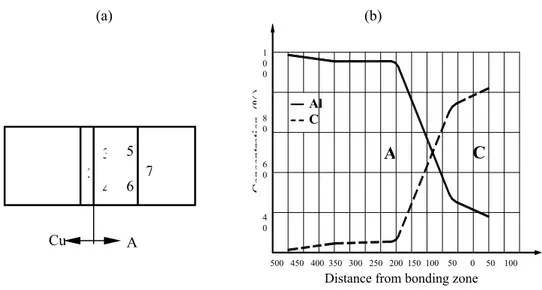BAÜ Fen Bilimleri Enstitüsü Dergisi (1999). 1 (2)
COMPARISON OF PROPERTIES OF FRICTION AND DIFFUSION WELDED JOINTS MADE BETWEEN THE PURE ALUMINIUM
AND COPPER BARS
İrfan AY, Sare ÇELİK, İbrahim ÇELİK Balıkesir University, Engineering and Architecture Faculty, Department of Mechanical Engineering, 10100, Balıkesir, Türkiye
ABSTRACT
Copper and aluminium material couples were joined by diffusion and friction welding methods which are able to weld in a solid state without melting. It was investigated the mechanical properties and microstructure of the welded specimens which are joined by both methods. This study shows that the intermetallic phases (Al2Cu, AlCu, Al4Cu9) occurred during the
welding processes have very important effect on the mechanical properties. As a result, diffusion welding process takes long time and the outer appearance of welding place is more uniform but the strength of bonding zone is lower than that of pure aluminium. Friction welding process takes shorter time and the outer appearance of welding place has a great amount of weld upset at the side of aluminium but the strength of welded zone is equal and higher than that of pure aluminium.
Key Words : Copper, aluminium, friction welding, diffusion
welding. ÖZET
Alüminyum ve bakır malzeme çifti, erime olmadan katı halde kaynaklanabilen sürtünme ve difüzyon kaynak yöntemleri ile birleştirildi. Birleştirilen kaynaklı numunelerin mekanik özellikleri ve iç yapıları incelendi. Her iki yöntemle yapılan kaynak esnasında oluşan intermetalik fazların (Al2Cu, AlCu, Al4Cu9) mekanik özellikler üzerinde çok önemli
etkisi olduğu görüldü. Sonuç olarak, difüzyonla kaynak uzun sürmekte, kaynak yerinin görüntüsü düzgün olmakta, fakat kaynak yerinin mukavemeti saf alüminyumun mukavemetine göre düşük olmaktadır. Sürtünme kaynağı daha kısa sürmekte, kaynak yerinin görüntüsü çıkıntılı, şişkin bir tarzda
olmakta, fakat kaynak yerinin mukavemeti saf alüminyumun mukavemetine eşit ve daha yüksek olmaktadır.
Anahtar Kelimeler : Bakır, alüminyum, sürtünme kaynağı, difüzyon kaynağı
1. INTRODUCTION
Usually, welding of dissimilar metals have great difficulties. The main difficulty is occurrence of intermetallic phase in bonding section. During the arc welding process of dissimilar metals, intermetallic phase occurs. For this reason, dissimilar metals cannot be joined using ordinary welding process. For the welding of dissimilar metals diffusion and friction welding processes have been considered for last two decades. Strength of the joint depends on thickness of occurred intermetallic phase and grain size of this layer. This case can often seen in Al-Cu welding process.
Table 1. Physical and mechanical properties of aluminium and copper
Properties Unit Aluminium
(Al) Copper (Cu) Density Resistance Thermal conductivity
Thermal coefficient of linear expansion Melting temperature Tensile strength Elongation Hardness g/cm3 (Ωmm2/m)x102 cal/cm2/cm°Cs (mm/mm°C)x10-6 °C N/mm² % HV 2.70 2.66 0.52 24.00 660.00 91.50 30.10 57.98 8.94 1.68 0.92 16.70 1083.00 220.50 36.67 106.90
Table 1 shows some physical and mechanical properties of Al and Cu. These metals have good electrical and heat conductivity and have good ability of casting and machining. Especially, these metals have high resistance of corrosion. For these reasons, these metals are used in chemical, food, automotive ship, electro-technique industries, and cold stores, gas charge equipment systems, as hollow and filled tubes bars and foils [1].
Wallach and Devies (1977), and Nielsen and Bay (1984) have been found that when intermetallic phase thickness exceeds 3-5 µm, brittle of bonding section increases, and strength decreases, considerably [2,3]. Kearus (1980) has mentioned that if Al-Cu is joined using friction, diffusion,
explosive and cold pressure welding, intermetallic phase thickness does not exceed 3-5 µm [4]. Nielsen and Bay (1984) have shown that intermetallic phase thickness is not exceed 5 µm in small diameters (less than 25 mm) for copper and aluminium diffusion and friction welding bar specimens [3]. However, when the specimen diameter exceed 25 mm, diffusion zone increases and intermetallic phase thickness passes 5 µm. Consequently, brittleness of bonding zone increases and its strength decreases [2]. The intermetallic phase occurrence is main difficulty for friction welding in Al-Cu. In addition to, this is a difficulty that removing of oxide layer from Al surface in diffusion welding of Al-Cu.
In this study, according to these background, experimental results of diffusion and friction welding have been compared for Al-Cu specimens which are less than 20 mm diameter. The comparison results include mechanical properties, micro structure of bonding zone, and information about occurrence of intermetallic phases. Welding of these type metal couples has great difficulty with conventional welding. Also advantages and disadvantages of diffusion and friction welding process have been presented and compared.
2. MATERIAL AND METHOD
Chemical compositions of Al-Cu specimens are given in Table 2. According to Table 2, aluminium and copper can be assumed pure materials.
Table 2. Chemical compositions (wt. %), for the pure aluminium and copper.
Copper Cu 99.78 Fe 0.13 Zn 0.09 Aluminium Al 99.18 Si 0.62 Mg 0.20
2.1 Friction welding process
In this process, mechanical energy is converted to heat. This heat brings to the specimen surfaces up to melting temperature or near to it. Touched surfaces are welded each other, in very short time, then suddenly
they are broken, but this process continues until forging of the specimens is established. At the end of the process, the specimens are joined under forging pressure. For the experiments, conventional friction welding machine have been used. The system can be seen in Figure1.
1. Drive motor 8. Piston rod 15. Spherical valve 2. V- belt 9. Double effective cylinder 16. Solenoid valve
3. Hoop 10. Electric panel 17. Power valve
4. Electromagnetic coupling 11. Hydraulic motor 18. Regulator of pomp pressure 5. Electromagnetic brake 12. Hydraulic pomp 19. Oil depot
6. Chuck 13. Direction control valve 20. Sucking line 7. Clamping ring 14. Manometer 21. Pressure line 22. Return line
Figure 1. Experimental set-up for friction welding and main parts [5]. The specimen have been machined in lathe down to required dimensions which are given in Figure 2.
∅ 18 70 ∅ 20 90
(a) Aluminium specimen fixed to (b) Copper specimen fixed to non rotating spindle chuck -rotational tail stock
Figure 2. Dimension of test specimens for friction welding
Dimension differences of Al specimen has been deliberately chosen because of low melting temperature of Al than Cu. This low melting temperature results with quick length reduction from forging pressure. This has been accepted that oxide layers of touching surfaces are removed during friction and forging pressure. Although, escaping from thick oxide layers surfaces are prepared using silicon-carbon paper grade 280-1200 and cleaned with alcohol and acetone.
Principle of operation
The Al specimen is clamped to rotating spindle chuck and the Cu specimen is clamped to non-rotational tail stock of lathe. During the Al specimen rotation, the Cu specimen is advanced to the Al specimen with gradually increasing friction pressure. With touching of specimen surfaces, the specimen surfaces temperature has been reached up to melting or near to it and then rotation has been stopped applying brake force. Applying with forging pressure, the welding process is completed. Parameters of the experimental conditions are taken from Gürleyik (1988), Kurban and Kahraman (1995) [6, 7].
These parameters are given as follows ; Spindle speed (n) : 3600 rpm Friction pressure (PR) : 6 N/mm²
Friction time (tR) : 2 s
Forging pressure (PS) : 8 N/mm²
Forging time (tS) : 1 s 2.2 Diffusion welding Process
Diffusion welding is a solid state process where at a temperature high enough for diffusion to take place at interface layers of the joint parts,
internal voids of the structure are closed by plastic deformation and bonds are formed at an atomic level [8].
For the experiments, the set-up can be seen in Fig. 3. Most of the similar experiments have been carried out in vacuum, but these experiments have been carried out in argon gas atmosphere [9].
Temperature control and power unit
Diffusion welding unit Refinery unit of argon gas
Argon tube
Figure 3. Diffusion welding apparatus
Al and Cu samples have been turned for the same diameter and then cut for the same length (See Fig. 4).
40 mm
∅
15 mm ∅15 mm
40 mm
Aluminium (Al) Copper (Cu)
Figure 4. Dimensions of test specimens for the diffusion welding Joining surface roughness and cleaning process are very important for the joining strength. The surfaces have been ground with silicon carbide paper grade 280-1200. The cleaning process may be carried out by acetone or carbon tetra chlorine. But, cleaning with carbon tetra chlorine can improve 14% joining strength than acetone cleaning process [10].
According to Kazakov and Kuznetsov (1985) the diffusion welding parameter are selected as follow [8] ;
Bonding temperature (T) : 560 °C Bonding pressure (P) : 4.5 N/mm² Bonding time (t) : 60 min.
After surface preparation, the copper specimen was placed at the bottom of the furnace and the aluminium specimen was located on top of copper specimen. Before heating, the welding chamber was completely filled with argon gas. The time for heating to the selected furnace temperature has been taken as average 30 minutes from the room temperature (20 °C). Required bonding pressure was applied on the specimens after reaching the selected furnace temperature up to determined times. Bonded specimens were left for free cooling down to 200 °C in the furnace.
3. EXPERIMENTAL RESULTS 3.1 Visual inspection
There was considerable deformation on the joining section and the weld upset on aluminium part of the joined samples using friction welding process. There was not any colour change on the joining section. Although, using diffusion welding, the appearance of welding zone was very smooth. There was only some colour changing on the aluminium side of bonding zone (dull and black) and copper side of bonding zone has very thin oxide layer (See Figure 5 and Figure 6).
Figure 5. Appearances of test specimens for friction welding (before and after welding)
Figure 6. Appearances of test specimens for diffusion welding (before and after welding)
3.2 Tensile tests
Tensile tests results are given in Table 3 for both process.
Table 3. Comparison of the tensile strength values for welded samples by friction, diffusion methods, and pure aluminium and copper specimens (N/mm²) [11].
Friction welding
Test number Without Annealing With annealing Diffusion Welding Pure Aluminium Pure Copper 1 139.00 79.00 60.45 91.00 220.00 2 177.00 90.00 62.10 91.00 220.00 3 155.00 107.00 59.86 91.00 220.00 Average 157.00 92.00 60.80 91.00 220.00
Tensile test results show that diffusion welding samples have the lower tensile strength than that of both friction welding and pure samples strength. This low strength may occur from different reasons. For example, one of the reason of this may come from different approach of the tests. Generally diffusion welding processes have been carried out in vacuum, but these test have been carried out in argon gases. These may effect of residual
air which can affect diffusion and bearing of very thin oxide layer on joining surfaces.
Friction welding tensile test results are grouped under two columns which show to annealing process effects. The annealing process decrease tensile strength of the samples. Because, the annealing process relieves hot or cold working stress. The annealing process shows real strength of the
friction welded specimens. This is the reliable strength of the specimens. This reliable strength has same value of pure aluminium strength.
As a result of tensile tests, fracture sections can be discussed for three type samples. All the fracture surfaces of the sample are brittle. For the diffusion welding specimens, fracture places are in aluminium side of welding zone. But it is very close the welding zone. For friction welding samples before the annealing, sample fracture zones are in aluminium side, but they are in welding section. After the annealing, the fracture site moves into the aluminium side.
As a result of the tensile values, this type diffusion welding (in argon gas with selected parameters) may be used only to place of the parts and it has advantage of smooth welding section.
3.3 Micro-hardness measurements
Following figures (See Fig. 7 and Fig. 8) show hardness changes in welding zone for three type welded samples. The hardness measurements point out that AlxCuy (Al2Cu, Al4Cu9, AlCu) phases occur in all the welding
zone.
(a) Before the annealing (b) After the annealing Figure 7. The change of micro-hardness in bonding zone of the friction welded
Al Cu
Al
Cu
interlayer
Distance from bonding zone (µm)
Mi cro -hardness (HV) 600 500 400 300 200 100 600 500 400 300 200 100 0 100 200 300 400 500
Figure 8. The change of micro-hardness value in bonding zone of the diffusion welding specimen for welding conditions t = 560 °C, P = 4.5 N/mm², t = 60 min.
It can be seen that Figure 7 shows friction hardness of welding section is the higher at the aluminium side than the copper side. Reason of this, aluminium melting point is the lower than that of Cu, and Al2Cu which may
occur at Al side (Al2Cu phase occurs at 150 °C). This occurrence may be
called as precipitation hardening and more information can be gathered from Van Vlack (1970) [12].
Samples with the annealing process has the lower hardness values than that of without the annealing processed samples. The annealing process relives residual stress and allows the phase changes. Consequently, hardness of the annealing carried out samples are lower.
In contrast, the higher hardness values have been found at copper side for diffusion welding samples. Reason of this may be occurrence of AlCu phase (It appears at 400 °C or higher temperature). This phase has thehigher hardness values and also brittle than that of other AlxCuy phases.
3.4 Metallographic examination (with optic and SEM microscopy) Micrographs have been taken from a section perpendicular to the cross section of the bonding zone. Before micrographs have been taken, they have been grounded by silicon-carbide papers (280-1200) and polished and then cleaned with acetone aluminium side of bonding zones have been etched by Keller solution and copper side of bonding zone have been etched by "copper ammonium chlorine - ammonium hydroxide" [13, 14].
For friction welding samples, microscopic examinations show that intermetallic phases have been pushed to aluminium side from copper side by forging pressure (See Fig. 9a). For annealing samples, the deformation mark have been change from curve shape to linear shape because of relieve residual stress (See Figure 9b).
Interface Interface
a) Before the annealing b) After the annealing
Figure 9. The microstructure of the joint zones for a friction welded specimens
For diffusion welding samples, first of all, samples which have maximum strength were selected. Figure 10 shows the microstructure of the bonding zone and its neighbourhood. The phases formed bonding zone were identified according to the aluminium-copper phase diagram and by comparison with micrographs from the relevant literature [11,12,13]. Al and Cu have composition of 60 mass Al% and 40 mass Cu%, θ crystals include intermetallic phases that are brittle
and hard. Chemical composition change of the materials at each side of the bonding zone was investigated with a scanning electron microscope equipped with EDS (energy disperse spectrometer) perpendicular to the joint plane over the bond zone between the pure copper and aluminium (See Figure 11a and Figure 11b).
(a) (b)
C
A
Al C 1 0 0 4 0 8 0 6 0 Concentration (%) 7 5 6 3 4 2 Cu A 500 450 400 350 300 250 200 150 100 50 0 50 100Distance from bonding zone
Figure 11. (a) Location of EDS analysis sites
(b) Concentration curve across the bonding zone of a pure Al-Cu diffusion bonded specimen
The results of EDS analyses and concentration curve of copper and aluminium pairs for the diffusion bonding conditions were shown (See Fig. 11b). It can be seen from Figure 11 that copper diffuses at low ratios but longer distances into the aluminium. In contrast, aluminium diffuses at high ratios but shorter distances into the copper. The cause of this phenomenon is the smaller atom diameter of copper to that of aluminium. Reason of the short diffusion distance of aluminium into the copper, it is the early formation (in short distance) of intermetallic phases in the copper. Another reason of different diffusion distances and ratio are concentration differences between Al and Cu. This is called Kirkendall effect. Diffusion coefficient can be determined from equation of D=XAlDCu+XCuDAl . This diffusion coefficient (D) is depended on
temperature and diffusion distance when main metal is copper.
Aluminium diffuses into the copper less than copper diffusion into the aluminium (at 500 °C, D=10-12.6 cm2/s) when main metal is aluminium,
copper diffuses to aluminium the higher than aluminium diffusion to copper (at 500 °C, D=10-10.3 cm2/s) [10].
From this investigation, following conclusions may be drawn ;
• The outer appearance of the diffusion welding samples for Al-Cu is the smoother than that of the friction welding samples.
• All the friction welding samples have the higher tensile strengths than all diffusion welding samples strengths (in argon gas).
• In friction welding, intermetallic is located at the Al side because of forging pressure. But, in diffusion welding intermetallic phases stay at the Cu side.
• For all the sample fracture places are at the aluminium of bonding zone. But only samples without the annealing treatment have broken in very close to pure aluminium side.
• The friction welded sample tensile tests show the annealing process reduces strength and hardness because of relieve of residual stresses from push up intermetallic phases.
• Diffusion welding time is the longer than friction welding, but the diffusion welding zones the smoother than the friction welding zones. • It is not possible to stop intermetallic phases occurrence for both
welding process.
• If the occurrence of intermetallic phase is minimised, the strength
of
welding can be improved.
• Diffusion welding process (in argon gas) cannot produce high strength welding zones to satisfy all the welding requirements (they may be used only for constrictive aim) because of intermetallic phases.
• Considerable strength reductions come from intermetallic phases, these phases details need to be study in advance.
5. REFERENCES
[1] Çelik, İ. “Alüminyum ve bakır çubukların sürtünme kaynağı üzerine bir araştırma”, Yayınlanmamış Yüksek Lisans Tezi, Balıkesir Üniversitesi, Balıkesir, (1997).
[2] Wallach, E.R., and Davies, G.J., "Mechanical Properties of Aluminium-Copper Solid-Phase Welds", Metals Technology, 4, 183-190, (1977)
[3] Nielsen, A., and Bay, N., "Friction Welding Copper to Aluminium", Ptoc Int. Conference on Joining of Metals JOM-2, 187-193, (1984).
[4] Kearus, W.H. (Hrsg), "Welding Handbook", American Welding Society, Vol. 3, Miami, (1980).
[5] Dabak, S. “Sürtünme Kaynak Tezgahı İmali, SAE 8620-1040 Malzemelerin Kaynağı ile Mekanik ve Metalografik İncelenmesi”, Yayınlanmamış Yüksek Lisans Tezi, Balıkesir Üniversitesi, Balıkesir, (1995).
[6] Gürleyik, M. “Sürtünme kaynağı ile birleştirilen alüminyum ile bakırın mikroskopik yapısı ve mekanik özellikleri”, Mühendis ve Makina Dergisi, 29, (1988).
[7] Kurban, A., ve Kahraman, N., "Farklı Metallerin Sürtünme Kaynağı ve Kaynak Parametrelerinin Kaynak Üzerine
Etkisi", 6.
Denizli Malzeme Sempozyumu, Denizli, (1995).[8] Kazakov, N.F., Translated from Russian : Kuznetsov, B.V., "Diffusion Bonding of Materials", Pergamon Press, First Ed., (1985). [9] Çelik, S. “Koruyucu gaz altında saf alüminyum ve bakırın difüzyon
kaynağı şartlarının belirlenmesi”, Yayınlanmamış Doktora Tezi, Balıkesir Üniversitesi, Balıkesir, (1996).
[10] Kazakov, N.F., "Diffusion Bonding of Materials", 53, 157-158, (1981).
[11] TS 138 "Metalik Malzemeler için Çekme Deneyleri", TSE, Ankara, (1978).
[12] Van Vlack, L.H., "Materials Science for Engineers", 168-185, (1970). [13] Schrader, A. (Çev. Anık, S.) “Dağlama Broşürü”, İ.T.Ü., (1968). [14] Tekin, E. “Demirdışı metaller ve alaşımlarının optik metallografisi”,

![Figure 1. Experimental set-up for friction welding and main parts [5].](https://thumb-eu.123doks.com/thumbv2/9libnet/5827445.119278/4.892.234.699.204.505/figure-experimental-set-friction-welding-main-parts.webp)

